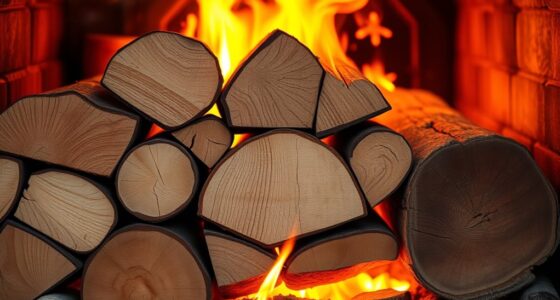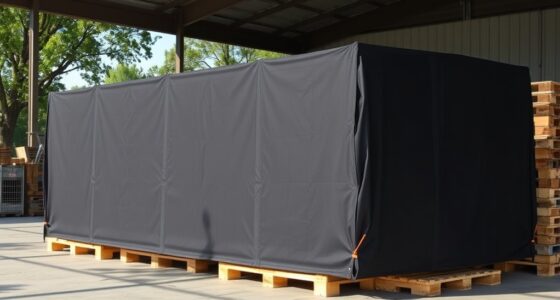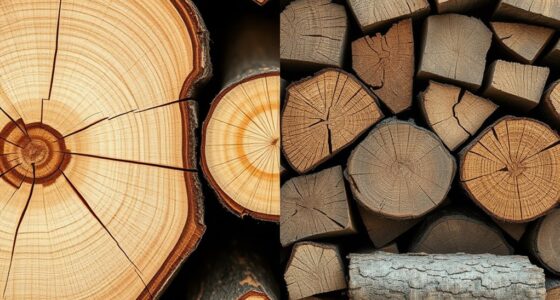Wood pellets are made by compressing raw materials like sawdust or wood shavings into dense, uniform shapes for easy burning. The process involves drying the raw material to reduce moisture, then grinding it into a fine powder. High pressure compresses the powder, binding it into solid pellets with high biomass density. This guarantees efficient combustion, consistent heat, and minimal environmental impact. To learn more about how the raw materials transform into fuel, keep exploring this fascinating process.
Key Takeaways
- Raw sawdust is dried to optimal moisture levels (6-10%) to ensure quality combustion.
- The dried sawdust is ground into a fine powder for uniform compression.
- High-pressure compression binds particles into dense, uniform pellets with high biomass density.
- Moisture removal during processing enhances pellet integrity and reduces emissions during burning.
- The final pellet composition balances biomass density and moisture content for consistent energy output.

Have you ever wondered what makes up the wood pellets used for heating and energy? The answer lies in understanding their composition, which is carefully engineered to maximize efficiency and sustainability. Central to this is biomass density, a key factor that determines how much energy each pellet can store. Biomass density refers to the amount of organic material packed into a given volume. Higher biomass density means more material in less space, resulting in a more energy-dense pellet that burns longer and delivers more heat per unit. Achieving ideal biomass density involves processing raw materials like sawdust, wood chips, or shavings to remove excess moisture and compressing them into uniform pellets. This guarantees consistent performance and easier handling. Proper processing techniques also help maintain the structural integrity of the pellets during storage and transport. Ensuring consistent material quality is essential for reliable pellet manufacturing and performance. Additionally, controlling the density of raw materials during processing can significantly influence the final pellet quality and energy output. Moreover, optimizing these parameters can lead to a more sustainable production process, reducing waste and environmental impact.
Biomass density in wood pellets boosts energy content and efficiency.
Moisture content is equally vital in the production process. Wood naturally contains moisture, but high moisture levels can compromise the pellet’s quality and energy output. When moisture content is too high, it causes the pellets to burn inefficiently, producing more smoke, ash, and greenhouse gases. This not only reduces energy efficiency but also increases wear on heating appliances. Hence, manufacturers carefully control and reduce moisture content during processing, typically aiming for a moisture level between 6% and 10%. This balance guarantees the pellets are dry enough to burn cleanly while maintaining their structural integrity. If the moisture content is too low, the pellets might become brittle and prone to breaking, which affects handling and storage. Conversely, if it’s too high, the pellets won’t burn properly, leading to incomplete combustion and higher emissions.
The process of making wood pellets involves drying the raw material to a specific moisture level, then grinding it into a fine powder. This powder is then compressed under high pressure, which naturally eliminates some moisture and binds the particles together into dense pellets. The resulting product is a compact, uniform fuel source that’s easy to store, transport, and use. The careful control of biomass density and moisture content ensures each pellet performs reliably, providing consistent heat output and minimal environmental impact. By optimizing these factors, manufacturers produce a fuel that’s both sustainable and energy-efficient, making wood pellets a popular choice for eco-conscious heating solutions.
In essence, understanding the composition of wood pellets reveals the science behind their efficiency. From the importance of biomass density to the critical role of moisture content, every step in the process is designed to create a high-quality fuel. So, next time you use a wood pellet, remember that its design is a careful balance of raw material preparation and precise manufacturing, all aimed at delivering clean, reliable energy.
Frequently Asked Questions
How Does Moisture Content Affect Pellet Burning Efficiency?
Higher moisture content in your pellets reduces combustion efficiency because it causes the fuel to burn less completely. The moisture impact means more energy is used to evaporate water, leading to lower heat output and increased ash production. To maximize burning efficiency, keep your pellets dry and moisture levels low. Proper storage in a dry place helps maintain ideal moisture content, ensuring you get the most heat from your pellets and reduce waste.
Are There Different Types of Wood Used in Pellet Production?
Think of wood pellet production like a chef choosing ingredients; yes, there are different types of wood used. You’ll find species diversity ranging from hardwoods like oak to softwoods like pine, each affecting burn quality. Regional sourcing also plays a role, as local trees influence pellet composition. For example, pellets made from Douglas fir in the Pacific Northwest differ from those using eucalyptus in Australia, offering varied burning characteristics.
What Additives Are Used in Some Wood Pellets?
You might find that some wood pellets include additive types like binders, preservatives, or anti-fungal agents to improve pellet quality. These additives enhance pellet performance by increasing durability, reducing dust, and preventing mold during storage. Pellet enhancement often involves natural or synthetic substances, ensuring the pellets burn efficiently and last longer. Always check product labels to know what additives are used, especially if you prefer eco-friendly or chemical-free options.
How Long Do Wood Pellets Typically Last in Storage?
In storage, your wood pellets typically last between 6 to 12 months if kept in a cool, dry place. Proper storage helps prevent pellet degradation, ensuring they stay efficient. Avoid high humidity and direct sunlight, which can shorten their lifespan. With good care, your pellets remain reliable fuel sources, maintaining their quality and burning well when you need them most. Proper storage is key to maximizing their longevity.
Do Pellet Compositions Vary by Region or Manufacturer?
Yes, pellet compositions vary by region and manufacturer. Regional variations occur due to locally available raw materials and specific climate needs, influencing ingredients and additives. Manufacturer formulations also differ to optimize combustion, reduce emissions, and meet safety standards. You’ll notice differences in density, ash content, and moisture levels, which can impact performance. It’s essential to choose pellets suited to your stove and location, ensuring efficient and clean burning.
Conclusion
As you explore the journey from sawdust to fuel, it’s no coincidence that small particles can power large dreams. Every pellet represents a mindful choice, transforming waste into warmth. When you realize how nature and human ingenuity intertwine, it reminds you that even the simplest materials hold profound potential. So, next time you see a pellet, remember—sometimes, the tiniest things can ignite the biggest change in our world.











